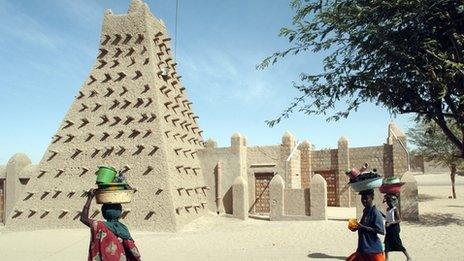Mali's Timbuktu and Askia Tomb put on Unesco danger list
- Published

The UN has been concerned about Timbuktu's historical sites since the March coup
The United Nations has said it is gravely concerned about Mali's historical city of Timbuktu as violence in the country's north escalates.
Unesco, the UN's cultural agency, said both Timbuktu and the 17th Century Tomb of Askia, which is in the city of Gao, had been placed on its list of sites in danger.
Islamist forces have just seized Gao from Tuareg rebels.
Unesco said it was also worried about looting and smuggling of artefacts.
Mali's government had asked the UN to recognise the threat to the condition of its historical sites and the high risk of trafficking of cultural objects.
Timbuktu, which is on the edge of the Sahara Desert, contains many examples of impressive and distinctive architecture which is hundreds of years old and constructed mainly from mud and wood.
The city is also home to about 700,000 ancient manuscripts held in about 60 private libraries.
Concern about Timbuktu's ancient sites was raised after a coup in March which overthrew the government.
Tuareg rebels and Islamist militants capitalised on the chaos and took control of the north of the country, but their uneasy alliance has all but collapsed.
Analysts say they do not share the same ambitions, with the Tuaregs wanting secession and Islamist fighters keen to impose Sharia law in the poor West African state.
The Tomb of Askia, a pyramidal structure which was built in 1495, is the burial place of the Emperor Mohammad Askia, who led the Empire of Songhai, one of the most successful Islamic empires in history.
Last month, al-Qaeda linked Islamist fighters were reported to have destroyed the tomb of a local Muslim saint in Timbuktu.
Strict Islamists regard shines as idolatrous, while some Muslims, especially Sufis, regard them as an accepted part of Muslim worship.